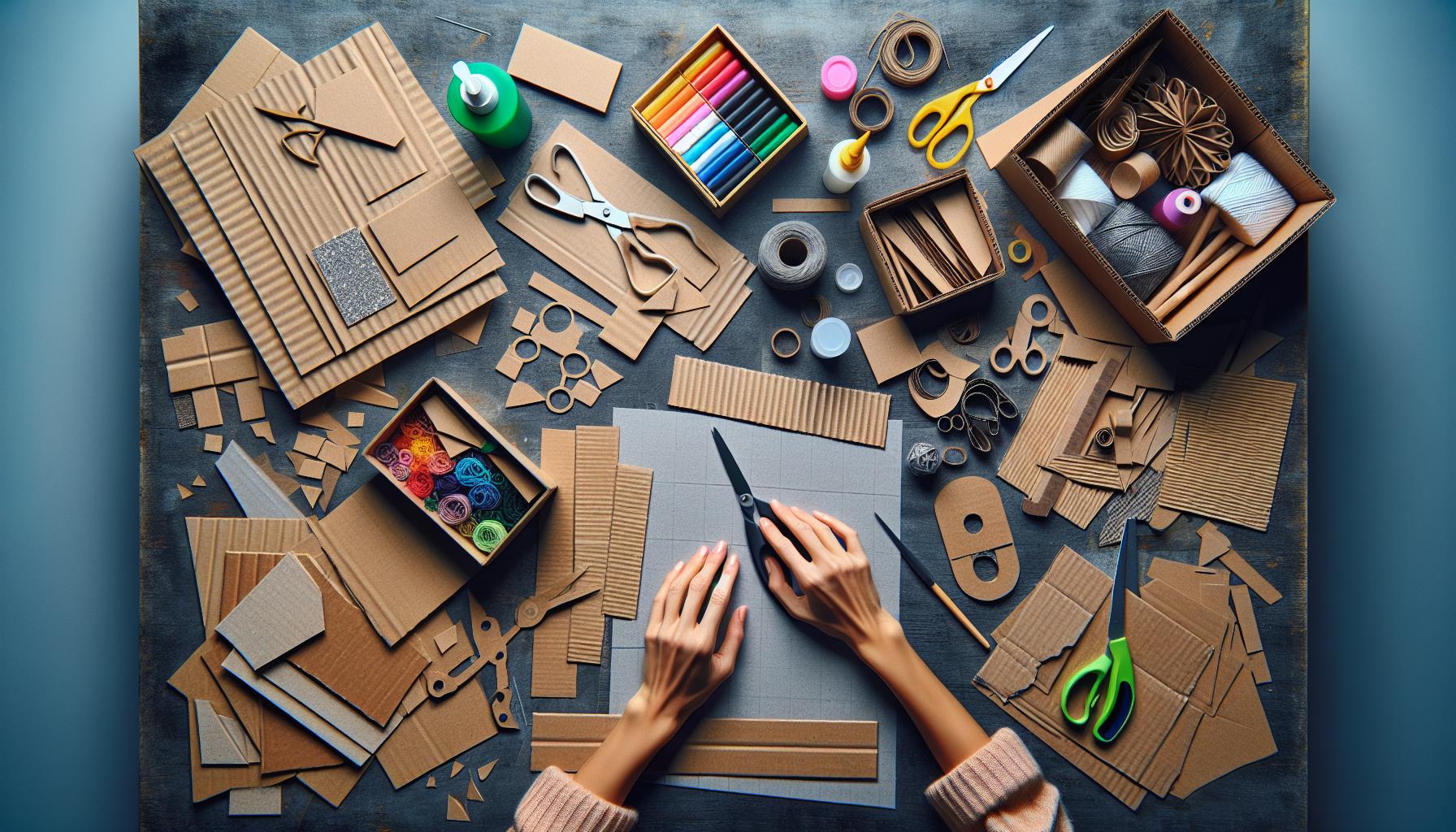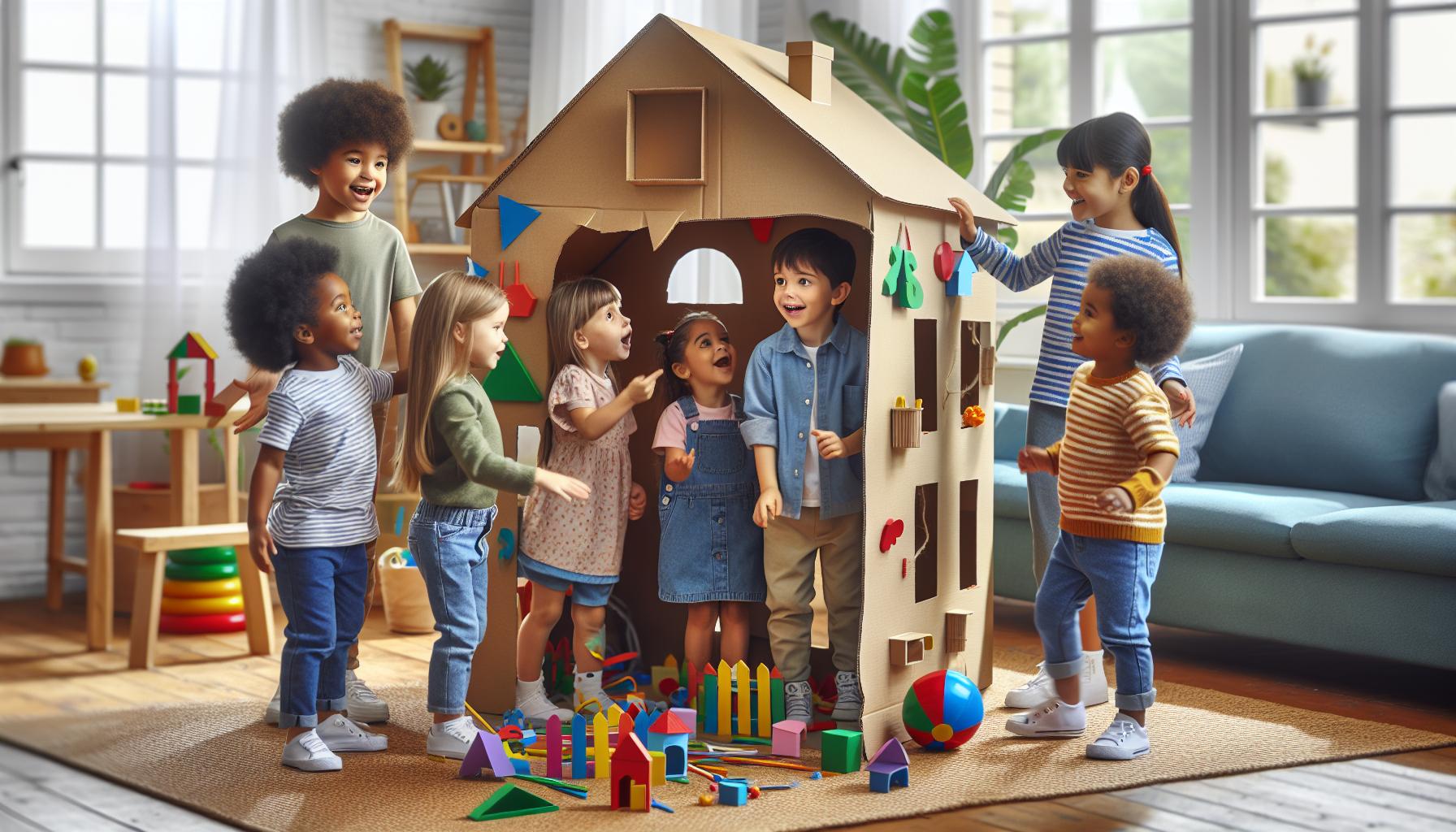I’ve always been amazed by the potential of cardboard—it’s more than just packaging material. With a little creativity and some basic tools, you can transform those leftover boxes into impressive DIY projects. Whether you’re looking to craft something practical or purely decorative, cardboard offers a sustainable and cost-effective solution.
Cardboard DIY projects are a fantastic way to upcycle materials that would otherwise end up in the trash. From creating storage solutions to designing custom home decor, the possibilities are endless. Plus, working with cardboard is accessible to everyone, regardless of skill level, making it a perfect medium for both beginners and seasoned crafters alike.
Key Takeaways
- Cardboard DIY projects are an eco-friendly and cost-effective way to upcycle materials, offering limitless possibilities for creativity and functionality.
- Suitable for all skill levels, these projects range from simple storage solutions to complex home decor and children’s play structures, making them accessible to both beginners and seasoned crafters.
- Essential tools for crafting with cardboard include utility knives, scissors, hot glue guns, and cutting mats, while choosing the right type of cardboard (corrugated or chipboard) depends on the project requirements.
- Personalizing cardboard projects with paint, decorative paper, or fabric adds aesthetic value and allows for unique, individualized creations.
- Engaging in cardboard DIY projects not only fosters creative expression but also contributes to environmental sustainability by reducing waste.
Cardboard DIY Projects
Transforming cardboard into functional projects engages creativity and resourcefulness. From furniture to home decor, cardboard DIY projects cater to various needs and preferences. For instance, converting a large box into a charming playhouse can entertain children for hours. When considering storage, creating customized shelves or organizers maximizes both space and efficiency.
Projects range from sophisticated to simple. Crafting a cardboard lamp involves cutting, folding, and layering cardboard to create intricate designs. This not only highlights its versatility but also adds elegance to any room. On the simpler side, painting and decorating small boxes for stationery storage provides a personal touch to any desk.
Popularity of cardboard DIY projects stems from their adaptability. Experimenting with different techniques like weaving strips or creating layered 3D art enhances creativity and skill. With minimal investment, cardboard can become a canvas for artistic expression. As an added benefit, engaging in these projects contributes to environmental sustainability by repurposing discarded materials into something valuable and beautiful.
Benefits of Using Cardboard

Cardboard offers numerous advantages for DIY projects, making it a popular choice among crafters. This material combines practicality with creativity for diverse uses.
Affordability and Accessibility
Cardboard is cost-effective, as it’s commonly available for free or at a low price. Many find it accessible since it often comes from everyday packaging like shipping boxes or consumer goods. This makes cardboard an ideal material for individuals with budget constraints or those seeking high-value crafting supplies without significant investment.
Eco-Friendly Material
Cardboard stands out for its environmental benefits by promoting sustainability. It’s recyclable and biodegradable, reducing landfill waste when repurposed for projects. Using cardboard minimizes dependency on new resources, making it a conscientious choice for eco-aware creators who aim to lower their environmental footprint.
Essential Tools and Materials

Successfully working with cardboard relies on having the right tools and materials. A small investment in basic supplies enhances creativity and craftsmanship, making projects more enjoyable and efficient.
Basic Tools Required
Precision tools make crafting with cardboard easier and more precise. A utility knife or craft knife is essential for clean cuts; use a metal ruler as a guide for straight lines. Scissors handle smaller, intricate cuts effectively. For joining pieces, a hot glue gun provides a strong hold, while masking tape offers a temporary fix. Use a cutting mat to protect surfaces and prolong the life of blades. Lastly, a pencil is crucial for marking measurements before cutting.
Types of Cardboard
Understanding the various types of cardboard improves project outcomes. Corrugated cardboard is common in shipping boxes and offers durability due to its wavy middle layer. It’s ideal for larger projects like furniture. Chipboard, usually found in cereal boxes, is smoother and thinner, perfect for detailed work such as crafting miniature models. Consider using cardboard tubes from toilet paper or paper towels for cylindrical structures. Each type serves unique purposes, making it easy to select the best option based on project needs.
Creative DIY Project Ideas

Cardboard offers limitless possibilities for creative projects at home. From stylish decor to engaging play items, these ideas make cardboard a valuable resource.
Home Decor Projects
I transform cardboard into elegant home decor items, like wall art or functional shelves. I create stunning geometric wall pieces by cutting cardboard into shapes and arranging them aesthetically. For functional use, I construct wall shelves by layering corrugated cardboard for added strength. Additional surface finishes like paint or decorative paper elevate these projects by adding personal flair.
Kids’ Play and Educational Projects
I craft exciting play structures using cardboard, such as playhouses or castles, that provide hours of amusement and learning. To encourage creativity, I design educational tools like alphabet or number tiles, cut from cardboard and decorated with bright colors. These projects not only entertain but also educate, fostering development through interactive play.
Organizational Solutions
I organize spaces effectively with cardboard DIY solutions, creating items like drawer dividers and storage organizers. Simple but effective, I craft these by cutting and folding cardboard to fit various drawer sizes, ensuring streamlined storage. To manage desk clutter, I build desktop organizers by stacking and gluing cardboard layers, providing designated spots for every item.
Step-by-Step Guide to a Simple Project
Creating a cardboard DIY project isn’t just easy, it’s also a rewarding way to upcycle materials. Here’s a clear approach to building a simple cardboard project.
Preparing Your Materials
The foundation of any successful cardboard project lies in preparation. I gather essential tools like a utility knife, scissors, and a hot glue gun. A cutting mat ensures precision and protects surfaces. It’s important to choose the right cardboard type; corrugated for strength or chipboard for detailed elements. A ruler helps in achieving straight cuts, while a pencil marks the design before cutting.
Building the Structure
Once the materials are ready, I outline the project layout on the cardboard. For structure stability, I score along the fold lines before bending. I then cut out each piece according to the design. Using hot glue, I join the pieces while ensuring edges align neatly. Consistent pressure while gluing helps achieve a seamless bond. It’s essential to let the glue set fully before moving on to additional steps.
Final Touches and Decoration
Decorating the project brings it to life. Paint and decorative paper can transform cardboard’s basic appearance. I apply a primer if using paint to ensure even coverage. For a more refined look, adding decorative tape or fabric can enhance the design. Personalization allows the project to reflect individual style, completing the transformation from plain cardboard to a unique creation.
Tips for Successful Projects
Crafting with cardboard offers immense possibilities, but ensuring project success requires attention to detail and creativity. Here are some key tips to enhance your cardboard DIY endeavors.
Ensuring Durability
Stability is crucial for any cardboard project, especially ones meant to last. Reinforce structures by doubling up layers; this improves strength significantly. For example, use corrugated cardboard for heavy-duty elements like furniture or large storage boxes. Securing joints with hot glue provides a robust bond, keeping pieces intact over time. Weatherproof paint or sealant protects projects from moisture, extending their lifespan.
Adding Personal Touches
Personalization transforms simple cardboard into unique creations that reflect your style. Incorporate decorative elements like paint, stickers, or fabric to elevate the aesthetic. Hand-drawn designs offer a creative outlet, adding artistic flair. For a cohesive look, coordinate colors with your existing decor by using matching hues or patterns. These touches not only enhance visual appeal but also infuse personality, making each project distinctly yours.
Cardboard Projects
Exploring cardboard DIY projects has truly opened my eyes to the material’s endless possibilities. From practical storage solutions to imaginative playhouses for kids, cardboard transforms into whatever I envision. Its eco-friendly nature and accessibility make it an ideal choice for anyone looking to craft creatively while being mindful of the environment. With the right tools and a bit of creativity, I’ve found that cardboard can be shaped into beautiful and functional pieces that enhance any space. Whether I’m a beginner or an experienced crafter, cardboard offers a versatile canvas for my artistic expression.

